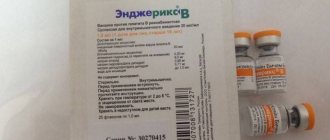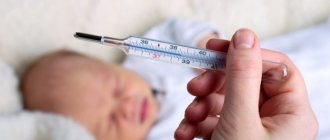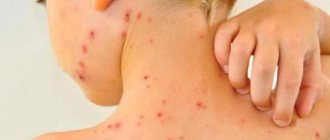Measles, rubella, and mumps are infectious diseases that pose a danger to human health. They can lead to damage to the central nervous system, encephalitis, meningitis, hearing loss, and blindness. If a pregnant woman gets rubella, the child is often born with deformities and pathologies. Mumps during pregnancy provokes miscarriage in 25% of women.
A comprehensive vaccination against rubella, measles and mumps (one vaccine against three infections at once) allows you to introduce an immunobiological drug into the child’s body. It will prevent future infection with these infections, which means it will protect the baby from real danger. Therefore, it is so important for parents to know as much detailed information as possible about this vaccination.
At what age
It is very important not to miss vaccination so that it is carried out in accordance with the vaccination schedule against these infectious diseases. Doctors should educate parents in advance when giving vaccinations against rubella, measles and mumps. The vaccine is administered three times: in infancy, on the eve of school and during adolescence. Repeated administration of the drug is called revaccination. A typical vaccination schedule for rubella, measles and mumps is as follows:
Repeated administration of the drug is explained by the fact that not all children develop immunity to these infections after the first vaccination. In addition, in this case there is such a thing as expiration date. Time passes, and artificially acquired immunity tends to weaken. Therefore, parents are advised to know exactly how long the vaccine against rubella, mumps and measles lasts by checking this calendar so as not to miss the next one. In adolescence, revaccination is necessary for several reasons:
- Extension of protection for girls who, over the next few (5-10) years, will give birth to children for whom rubella and mumps viruses are dangerous during intrauterine development.
- Immunity against measles is successfully activated when encountering the vaccine virus.
- Extension of protection for young men for whom mumps is extremely undesirable at this age (one of the complications of this disease specifically for men is infertility).
If a child for some reason has not been vaccinated, he is vaccinated at 13 years of age. On average, the validity of vaccinations against mumps, measles and rubella is about 10 years: this is the frequency with which the population is vaccinated. However, during outbreaks of infection, vaccinations are given unscheduled, which makes it possible to extinguish outbreaks of disease.
Measles vaccines
In medical practice, mono-vaccines produced in India, Croatia, France, Russia and combined ones – produced in the USA and Belgium – are used. Such preparations contain live parts of rubella, measles and mumps (MMR). Their joint administration does not complicate the post-vaccination period in any way, is easily tolerated and creates lasting immunity.
Two types of combined vaccines are registered in Russia - Priorix, produced in Belgium, and MMR-II, produced in the USA.
Priorix
The combined Belgian vaccine contains killed parts of the rubella, mumps and measles virus. Its introduction is indicated both for the prevention of one of the included diseases, and for all of them at once. If the immunized person already has antibodies to measles (after an illness), then vaccination is not contraindicated.
A single dose of the vaccine 0.5 ml is administered subcutaneously. Priorix is stored in the form of two components, lyophilisate (laboratory-dried powder) and water for injection (solvent). Dilution is carried out immediately before dose administration, in compliance with all aseptic and antiseptic conditions. The injection site must be treated with alcohol. It is strictly contraindicated to administer the vaccine intravenously.
MMR-II
American combivaccine against rubella, mumps and measles. Like Priorix, this is a live vaccine (contains a live virus), presented as a lyophilized powder and solvent. Also grown on chicken egg white.
Rudivaks
French monovaccine containing a live but weakened strain of the virus. Forms stable immunity to the disease within 15 days after vaccination. Rudivax is acceptable for use in children under one year of age, but its effectiveness in this case is questionable.
Babies up to 12-15 months can retain maternal antibodies and their own immunity in the blood. In a child vaccinated according to the calendar or epidemic indications, the developed resistance can last up to 20 years. Rudivax may contain traces of neomycin (an antibiotic from the aminoglycoside group) and is contraindicated in case of individual intolerance to this substance.
Vaccines are well tolerated and provide lasting immunity. Complications after their use rarely occur.
Before immunization, the patient must be examined by a therapist (pediatrician, for children) or a paramedic.
Simultaneous vaccination with several live vaccines is not allowed. You cannot give the MMR (Measles, Mumps, Rubella) and BCG vaccine on the same day. The PDA can be freely combined with all the others from the national calendar on one day; this does not put an unnecessary burden on the immune system and is not dangerous.
Place of vaccination
Since the first vaccination is given to a very small baby, parents are worried about where to get the rubella vaccine for their baby. Here are the medical rules:
- at 12 months the drug is injected into the thigh, namely into its outer surface;
- in other cases - into the shoulder muscle.
The choice of these particular sites for grafting is not accidental: the skin here is thin, the muscles are close to its surface, and there is no subcutaneous fat at all. If the vaccine gets into the fat layer, it will lose its beneficial, healing properties. It is not done in the buttocks, since in this place the muscles are deep, the fat layer under the skin is thick, and there is a risk of touching the sensitive sciatic nerve.
Contraindications
Unfortunately, not all children may be vaccinated with this vaccine. There are a number of contraindications due to which these vaccinations can, unfortunately, be postponed indefinitely, or may be prohibited for life. Temporary contraindications for vaccination include:
- acute course of illness (you can get vaccinated immediately after recovery);
- pregnancy (vaccination is carried out immediately after childbirth);
- simultaneous administration of blood products (vaccination is done only after a month).
There are also permanent contraindications, which include:
- allergic reaction to certain medications (neomycin, gentamicin, kanamycin);
- allergy to egg white;
- neoplasms;
- complications after receiving the vaccine for the last time.
In these cases, vaccination is not carried out at all, so as not to worsen the child’s condition with complications.
Complications
Complications after vaccination against measles, rubella, mumps are rare, but do occur. Among them:
- allergic reactions - anaphylactic shock, urticaria, severe swelling at the injection site;
- encephalitis;
- serous aseptic meningitis;
- decrease (temporary) of platelets in the blood;
- pneumonia;
- abdominal pain;
- glomerulonephritis;
- toxic shock syndrome.
In such severe cases, it is necessary to urgently seek help from doctors. After a thorough medical examination, contraindications for further vaccination of the child will most likely be identified. However, not only complications can a small organism react to vaccination. The consequences involve a number of side effects.
Reaction to vaccination (consequences)
Usually, side effects after vaccination (measles, rubella, and mumps) frighten parents very much, although doctors immediately warn about them and notify that this is a normal reaction of a small organism. This means that the child’s immunity is actively working. This is not a pathology, no treatment is necessary, and in this case it makes no sense to refuse this vaccination in the future. These side effects include:
- after vaccination against rubella, a small rash appears on the body;
- runny nose;
- temperature increase;
- joint pain;
- cough;
- discomfort at the injection site.
These side effects should appear from 5 to 15 days after administration of the vaccine. If symptoms do not fall within the specified period after immunization, they are not related to it.
Types of vaccinations
You can get vaccinated against rubella at the clinic at your place of registration. The doctor usually informs you about the timing of immunization. If desired, the child’s legal representatives can write a refusal to vaccinate at a budget organization and receive the vaccination for a fee. In this case, you can choose the type and name of the vaccine.
The following vaccinations are currently used for rubella vaccination:
- MMR. An American vaccine that can be used in children from 9 months. It also contains pathogens of mumps and measles. The injection provides protection against three dangerous diseases at once. There is also the MMRV vaccine, which provides additional protection against chickenpox.
- Priorix. Serum developed in Belgium. Develops immunity against measles, rubella and mumps. It is prescribed to children after one year, and repeated administration is recommended 5-6 years after the first.
In addition to combined vaccinations, children are given mono-vaccines against rubella. Such serums contain only purified pathogens of this disease and do not form immunity against other infections. Single-component vaccinations are used when there is no possibility or indication to administer a combined one.
Rubella monovaccines:
- Ervevax;
- Rudivax;
- Live vaccine against rubella.
Rubella vaccination and pregnancy
During pregnancy, all infections pose a threat to pregnancy. The rubella virus is considered especially dangerous for an unborn child. It penetrates through the placenta to the baby, affects him, leads to death, causes pathologies and deformities. Therefore, vaccination against rubella before pregnancy should be done in advance in order to protect the unconceived child and yourself. During the period of bearing the baby, this will no longer be possible: only after childbirth. It’s good when parents think about this even when planning a pregnancy: vaccination in this case is as successful as possible. The expectant mother’s immunity is strengthened, and the baby is no longer in danger. Moreover, pregnancy after rubella vaccination proceeds calmly, without complications or pathologies.
The need for rubella vaccination
Rubella is an infectious disease caused by a virus. The incubation period for development after infection with a pathogenic microorganism ranges from two weeks to 24 days. A person begins to secrete the virus a week before the first symptoms appear. Rubella is easily tolerated by children. There may be a slight increase in temperature, symptoms of intoxication, a rash on the skin, the disease rarely causes complications.
Epidemiologists associate the need to vaccinate people against the rubella virus with the fact that this disease is especially dangerous for a pregnant woman. If the virus enters the fetal tissue through the placenta, then the following may be detected in the newborn baby:
- heart and eye defects;
- microcephaly;
- deafness;
- mental retardation.
If infection occurs in the first four weeks of pregnancy, the risk of developing defects reaches 60%. Therefore, the rubella vaccination is done primarily in order to interrupt the circulation of the virus among people and thus prevent infection of the expectant mother. Vaccinations are not always carried out in childhood. But this does not mean that older people do not need immunization.
The development of rubella in adulthood is more difficult to tolerate, the symptoms of intoxication are more pronounced, and complications in the form of encephalitis may occur. The vaccine is given to unvaccinated adults with the aim of completely eliminating the infection.
Vaccines
There are several types of vaccination against measles, rubella and mumps. They depend on the type of viruses included in the vaccine. All of them are of high quality, safe, effective and interchangeable. In addition, there are:
- three-component vaccine - a preparation containing three types of viruses;
- dicomponent - a combined vaccine against any two diseases;
- monocomponent - a vaccine against only one infection.
Depending on the country of origin, domestic and imported drugs are distinguished.
- Domestic
- advantage: prepared on the basis of Japanese quail eggs;
- disadvantage: there are no three-component drugs, so the injection has to be done twice.
- Imported
- advantage: easy to use, as it is three-component;
- disadvantage: not always accessible to the common man;
- brands: MMR-II (America, Holland), Priorix (Belgium); "Ervevax" (England).
A comprehensive triple vaccination of measles, rubella, mumps was created to protect against infections that are potentially dangerous for children and adults.
source: www.vse-pro-detey.ru
March 27, 2017
Vaccinations and injections
Rubella is a common viral infection that is transmitted only from person to person. The disease leads to the development of a skin rash, damage to the lymph nodes, and general intoxication. The infection is usually easily tolerated. However, the disease can threaten the life and health of the unborn child if a pregnant woman is infected. The only effective method of protection against a viral disease is the rubella vaccine.
Vaccination strategies
After infection, adults and children become a source of pathogenic viral particles for 14 days before the onset of symptoms and 21 days after. In this case, the release of the rubella virus is noted in urine and feces. However, newborns with congenital rubella are especially dangerous. In such cases, the virus remains in the child’s body for up to 12 months, during which children are able to infect others.
Important! Universal vaccination against rubella of the population will completely eliminate the viral infection from the list of diseases that can affect humans. This method made it possible to defeat a deadly disease - smallpox.
Therefore, the World Health Organization (WHO) staff developed 3 effective strategies. They are aimed at reducing the risk of developing congenital rubella syndrome and the circulation of viral particles in the human population. The following tactics are distinguished:
- Vaccination against rubella in adolescent girls and patients of reproductive age. This allows you to form stable protection against viral infection and completely prevent the development of a dangerous syndrome in newborns.
- Vaccinations against rubella are carried out in children under 1 year of age, adolescents, and people of reproductive age (up to 40 years). To completely eliminate the infection, universal immunization of the population will be required within 15-20 years.
- Vaccination against rubella in childhood and adolescence (12 months, 6-7 years, 14-15 years). This tactic is aimed at eliminating the circulation of the virus within 20-30 years.
Vaccination dates
Rubella vaccination, when is vaccination done and how long does immunity last? Vaccination of the population is carried out only with drugs that have passed clinical trials.
Monitoring vaccinated people and determining the level of their antibodies to rubella made it possible to establish that
:
- in a small proportion of people immunity remains for life;
- in approximately 95% of unvaccinated people, immunity against rubella works during the first 15-20 years after vaccination;
- For some, antibodies are not activated after the first vaccination.
In this regard, a unified vaccination plan for the population has been developed and is being used in Russia:
- The first vaccination against rubella is carried out at 6 years of age;
- revaccination at 6 and 15-17 years of age.
Giving children the first and second vaccinations allows them to be reliably protected from rubella before puberty. Then immunity gradually decreases, so after 15 years another vaccination is necessary. Vaccination dates may be postponed for medical reasons.
After reaching 18 years of age and up to 35-40 years of age, all women are given the vaccine if 5 or more years have passed since the last vaccination against rubella.
How many times should the rubella vaccine be given during a lifetime? The official vaccination calendar provides for three-time vaccination against the rubella virus, but vaccination can be carried out more often if indicated. The World Health Organization recommends that adults be vaccinated every 10 years.
Types of vaccine preparations
The rubella vaccine is based on weakened viral particles. After injection, the pathogen enters the bloodstream, causing the development of erased symptoms of infection. Vaccination also triggers the body’s immune response to foreign bodies. As a result, antibodies against rubella are actively produced.
Important! Vaccination prevents the occurrence of an infectious process when the rubella pathogen enters the body of vaccinated people.
Rubella vaccination is done using the following vaccine agents:
- Combined (Belgian Priorix, American MMR). The drugs include several types of weakened viruses. This allows the patient to develop immunity against several infections at once. Vaccines against measles, rubella and mumps are widely used to create immunity in children and women planning pregnancy. The disadvantage is that it is highly reactogenic, so vaccination often provokes the development of adverse reactions;
- Single-component: Ervevax (England), Rudivax (France), Live rubella vaccine (Russia). The drug is created on the basis of only weakened live rubella viral particles. The vaccine is easily tolerated and rarely causes side effects. The monovalent rubella vaccine is used mainly in adults for emergency vaccination.
Many parents try to vaccinate their children separately against rubella, measles and mumps, justifying their choice by the low risk of side effects. But this opinion is wrong. In such situations, the load on the immune system only increases, because every time a vaccine is administered, the body experiences stress. Therefore, in highly developed countries, combination preparations for immunization are widely used.
Procedure
We have found out at what age children are vaccinated against rubella (measles, mumps). It remains to understand how the procedure is carried out. The drug is administered intramuscularly or subcutaneously. The place for penetration may be the forearm or buttock. After the injection, the vaccine activates the production of antibodies, which will subsequently protect the body from “real” pathogens.
Protection can be passive or active. This depends on the type of immunization. In the first case, the administered drug contains weakened pathogens, in the second, antibodies in the form of immunoglobulin. This provides protection to the body for a short period of time.
Passive vaccination is more often given to pregnant women who have been in contact with sick people.
The rubella vaccination is given under aseptic conditions: when it is done, they use a disposable syringe and a sterile needle; The number of times the drug is administered is the number of times the work surface is sterilized. The procedure can only be performed by a medical professional. Before opening the ampoule, he must pay attention to its contents. If the composition has changed its color or consistency, then it cannot be used for its intended purpose.
Features of vaccination
Before any immunization, every child must undergo an examination by a pediatrician. This will prevent vaccination of a sick patient. The rubella vaccine is administered intramuscularly. For children under 12 months, the injection is placed in the thigh, for patients over 6 years old - in the shoulder or under the shoulder blade. The manipulation is carried out in the treatment room of the district clinic.
Important! The rubella vaccine cannot be given into the gluteal muscle. Subcutaneous fatty tissue is well developed in this area, which will reduce the rate of absorption of the vaccine. There is also the possibility of damage to the sciatic nerve.
Vaccination against rubella should be carried out taking into account the following rules:
- Immunization should be carried out by specially trained medical personnel under aseptic conditions;
- The administration of the rubella vaccine is carried out with a disposable sterile syringe, which has a thin needle with a beveled bevel;
- Before the procedure, the nurse should carefully examine the vaccine product. If the color of the rubella vaccine has changed, the suspension should not be administered;
- The ampoule with the vaccine preparation is treated with an antiseptic and opened immediately before injection;
- The skin on the leg or arm should be treated with a sterile swab, previously soaked in an antiseptic;
- Next, the rubella vaccine is administered, and the injection site is re-treated with an antiseptic.
Quite often, parents refuse the rubella vaccine because they are afraid of developing adverse reactions after vaccination. However, this vaccine preparation is easily tolerated and causes virtually no complications. It should be borne in mind that the effectiveness of immunization reaches 95%. And compliance with the listed requirements will reduce the risk of infection of the injection site and the severity of local side effects.
Vaccination schedule
According to WHO recommendations, the following vaccination schedule is used in Russia:
- The first rubella vaccination is given to children up to 12 months (in other developed countries - 9-15 months);
- Children are given the second rubella vaccine at 6-7 years of age. Two vaccinations help build strong immunity against infection before puberty;
- Revaccination is carried out in adolescent children aged 13-15 years.
If a woman is planning a pregnancy, it is recommended to get an additional vaccination against rubella if more than 5 years have passed since the previous vaccination.
Important! The presence of immunity to rubella can be determined by testing the blood for the presence of antibodies to the infectious disease. Their absence indicates the need for re-immunization.
It is important to remember that the severity of the immune response to the entry of the rubella virus into the body is not the same and is determined by individual characteristics. And the duration of protection from a viral disease can vary from 5 to 40 years. Therefore, WHO staff recommend that adults be vaccinated against rubella every 10 years.
Possible side effects
In children, vaccination against rubella rarely leads to the development of adverse reactions, if the child is absolutely healthy and the basic rules of vaccination have been followed. In adulthood, vaccination is more difficult to tolerate - the risk of unwanted symptoms increases.
In patients of all age groups, immunization can lead to the following side effects:
- Redness and soreness at the injection site. Possible enlargement of the lymph nodes, which are located in the area adjacent to the injection site (axillary region, neck);
- Weakness, slight increase in temperature, signs of general intoxication;
- Joint pain in older children.
The listed symptoms do not require special therapy. It is quite rare to use painkillers and antipyretic drugs.
If vaccination is carried out without taking into account contraindications, the following conditions may develop:
- The appearance of small red or purple spots - roseola. The rash does not require the use of antiviral drugs and goes away on its own in 3-4 days;
- Allergic reactions: urticaria, angioedema;
- The development of rubella if immunization is given to a patient with severe immunodeficiency.
After vaccination: possible reactions and complications
Any child can have a reaction to the rubella vaccine. The formation of immunity does not go unnoticed. The norm is:
- a slight increase in body temperature that does not require taking antipyretic drugs;
- local enlargement of lymph nodes in the area of serum injection;
- general malaise and loss of appetite;
- painful sensations in the joints;
- headache.
The rubella vaccine rarely causes side effects . However, parents are always warned in which cases they should consult a doctor:
- the appearance of a rash on the body;
- high body temperature;
- indigestion;
- swelling and redness at the site of serum injection;
- inflammation of the joints, accompanied by local redness of the skin.
Do adults need immunization?
Vaccination against rubella is recommended for all women who have reached reproductive age, unless they have previously had a viral infection. This will reduce the risk of developing severe malformations in the fetus. If the state has the financial opportunity, vaccination is recommended for men under 40 years of age. This is necessary to reduce the circulation of the infectious agent in the population.
Important! Rubella vaccinations given to men of reproductive age help protect women and children who come into contact with them from infection.
In Russia, adults are vaccinated against rubella at the age of 22-30 years, when most women want to have children. In addition, in such patients, immunity may weaken after the last immunization in adolescence. Therefore, women need additional protection. The rubella vaccine helps build immunity for the next 10 years.
Important! Subsequently, immunization occurs at 33-39 years of age. Vaccination is not performed because patients in this age range rarely give birth.
Rubella vaccine should be used in the following populations who were not immunized in childhood:
- College students and students;
- Employees of medical institutions;
- Patients who travel frequently;
- Women whose age is between 20-35 years.
Types of rubella vaccines
Vaccines against the rubella virus are based on artificially weakened viral components.
They cannot cause disease; vaccination only leads to the active production of antibodies to the infectious pathogen.
People are vaccinated against rubella using different types of vaccines.
| View | Compound | Name |
| Single-component vaccines | Single-component preparations contain only weakened rubella viral particles | Imported vaccines - Rudivax, Ervevax. Russian rubella vaccine |
| Combination vaccines | They are created on the basis of several infectious pathogens. Most often, a vaccine is given at once, including weakened components of measles, rubella and mumps. | Priorix, MMR. |
It is customary for children in Russia to receive a multicomponent vaccine. Some parents believe that the single-component composition of the drugs acts more gently and at the same time reduces the risk of developing unwanted reactions.
On the one hand, this is true, but the body recovers faster and the immune system suffers less when a child receives several weakened viruses at once.
Vaccination of children and approved revaccination of adults is free of charge.
The danger of rubella for pregnant women
The infectious disease poses a particular danger to pregnant women. The expectant mother tolerates the infection easily, but in 80% of patients, the introduction of the rubella virus provokes severe developmental abnormalities in the fetus. In this case, the outcome of the disease is determined by the duration of pregnancy.
The greatest danger is posed by infection of a woman for up to 12 weeks, when the formation of vital organs in the fetus occurs. In such cases, defects that are incompatible with life develop. Therefore, pregnancy ends in fetal rejection and miscarriage.
If the infection occurred after the 20th week of pregnancy, then several options for events are possible:
- The birth of a full-fledged child. This is only possible with timely and effective treatment of the mother. However, a newborn may develop congenital rubella syndrome;
- The occurrence of developmental defects. The baby may have heart problems, nervous system pathologies, mental retardation, and damage to the auditory and visual apparatus. Some newborn babies die from complications within 1 month after birth.
Is immunization necessary before pregnancy?
Vaccination against rubella during pregnancy planning is an effective and safe method of protecting the child from the negative effects of viral particles. Vaccination is recommended 1 month before expected conception. The infectious agent is dangerous to the fetus, so WHO recommends against immunization of pregnant women.
Important! If a woman is accidentally vaccinated against rubella in the early stages of pregnancy, doctors do not recommend an abortion. It is enough to regularly monitor the condition of the fetus.
To exclude accidental immunization of pregnant women, it is recommended to identify such patients before vaccination. According to long-term observations, vaccination against rubella during pregnancy does not lead to the development of congenital disorders in the baby.
How to behave before and after vaccination?
No special preparation for immunization is required. However, to prevent the reaction to the rubella vaccine from being intense, doctors recommend adhering to the following recommendations:
- If you are prone to allergies, you should take antihistamines in an age-appropriate dosage 2-3 days before the injection;
- Frequently ill children are advised to take restoratives 7-10 days before vaccination. This will help reduce the risk of developing a secondary infection or exacerbation of chronic pathologies;
- It is not recommended to have a large breakfast before the injection;
- If a child takes vitamin D, treatment should be stopped 3-4 days before vaccination. Therapy is resumed after 5-6 days.
After vaccination, it is not recommended to immediately leave the clinic. Doctors advise staying on the premises of the medical facility for 30 minutes so that staff can provide timely assistance if allergies develop. If there is no fever after vaccination, walks are allowed. However, it is necessary to avoid crowded places for several days to prevent contact with infected people.
Important! If a child attends kindergarten, then after vaccination it is recommended to stay at home for several days.
After immunization, new foods should not be introduced into the diet to avoid the development of an allergic reaction. You need to eat small meals, avoiding overeating and eating fatty foods. You should drink more fluids (jelly, clean water, herbal teas). This will improve the patient’s well-being and will facilitate the rapid evacuation of toxic substances from the body.
Important! Adults will have to abstain from drinking alcohol for 7 days after immunization. After all, alcoholic drinks will interfere with the development of immunity.
Preparing for immunization
Rash and other side effects are not common after rubella vaccination. Therefore, immunization does not require specific preparation. Usually, for a child at 12 months of age, a scheduled consultation with specialized specialists is scheduled, who, in addition to the examination, exclude possible contraindications in their field. The baby is also given a blood test and other examinations. If the pediatrician finds no reason for medical withdrawal, then preparation for vaccination is completed.
For children who are prone to allergies, it is recommended to take antihistamines before vaccination. This reduces the likelihood of negative manifestations in the form of skin reactions. Also, before vaccination, you should not introduce new dishes into the diet, and you should adhere to a hypoallergenic diet 4-7 days before vaccination.











